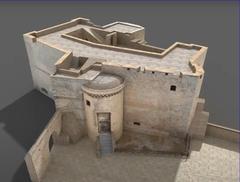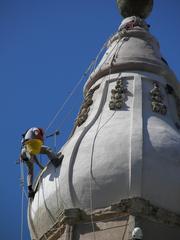Santa Maria Amalfitana Visiting Hours, Tickets, and Travel Guide – Monopoli, Italy
Date: 14/06/2025
Introduction: History and Cultural Significance
In the heart of Monopoli’s historic center, the Chiesa di Santa Maria Amalfitana is a striking testament to the town’s rich medieval past and enduring connection to the maritime Republic of Amalfi. Founded by Amalfitan merchants in the 11th–12th centuries, this Romanesque church blends robust stonework and semicircular apses with later Gothic and Baroque elements, mirroring Monopoli’s evolution as a crossroads of Mediterranean cultures. Originally serving as a spiritual and communal hub for Amalfitan settlers fleeing Saracen invasions, Santa Maria Amalfitana became a symbol of resilience and integration, shaping Monopoli’s identity through the centuries (Turismo in Puglia, Italian Trip Abroad, Carnets Voyages).
Today, visitors can explore its tranquil interior—home to medieval fresco fragments, a crypt of early religious significance, and sculptural works that narrate centuries of artistic evolution. The church’s modest façade and intimate scale invite quiet reflection, while its role in hosting events such as the Monopolele Mediterranean Ukulele Festival highlights its vibrant place in contemporary Monopoli (monopolele.com).
This comprehensive guide details Santa Maria Amalfitana’s visiting hours, ticket policies, accessibility, and nearby attractions, alongside historical and architectural insights to enrich your visit. Whether you’re a history enthusiast, architecture lover, or cultural traveler, Santa Maria Amalfitana opens a unique window into Monopoli’s layered past and living heritage (Tourist Secrets, Vivi la Puglia).
Table of Contents
- Introduction
- Origins and Early Development
- Architectural Features
- Artistic and Cultural Heritage
- Restoration and Preservation
- Visitor Information: Hours, Tickets & Tours
- Accessibility and Tips
- Nearby Attractions
- Frequently Asked Questions (FAQ)
- Conclusion
- References
Origins and Early Development
Santa Maria Amalfitana’s roots reach back to the 11th century, when Amalfitan refugees established a vibrant community in Monopoli after fleeing Saracen raids. The church was constructed to serve their spiritual needs, anchoring an Amalfitan quarter and reflecting the town’s openness to external influences (Turismo in Puglia). The site likely overlays earlier sacred buildings, as Monopoli’s old town evolved atop ancient Messapian and Roman settlements (Turismo in Puglia).
Architectural Features
Exterior
The church’s façade is a harmonious blend of Romanesque solidity and later Baroque touches, built from finely hewn local limestone. Its relatively austere portal is topped by a rose window, while a bell tower—added in later centuries—offers sweeping views over old Monopoli (Tourist Secrets).
Interior
Inside, a nave with side aisles is separated by sturdy columns and rounded arches, typical of Romanesque basilicas. Some columns may have been repurposed from earlier Roman or Byzantine structures, highlighting Monopoli’s layered history. The semicircular apse and raised presbytery feature intricate stonework and, in places, Baroque marble inlays. The interplay of natural light from clerestory windows and the rose window creates a contemplative atmosphere.
Crypt
Beneath the main sanctuary lies a remarkable crypt, older than the current church, accessible via a staircase near the altar. It consists of chapels and burial niches cut into the rock, adorned with medieval frescoes and inscriptions (Carnets Voyages). The crypt’s low vaulted ceilings and stark stonework contrast with the upper church, exemplifying the evolution of religious architecture in Monopoli.
Artistic and Cultural Heritage
Fresco fragments in the crypt and side chapels date from the 12th to 14th centuries, depicting scenes from the lives of the Virgin Mary and saints in the vivid, stylized manner of Apulian-Byzantine art. Baroque renovations added stucco, gilded altarpieces, and painted wooden ceilings, reflecting changing religious aesthetics.
Notable sculptural works include a 16th-century marble Madonna and Child, revered locally and featured in religious processions, as well as intricately carved capitals and bas-reliefs on the portal (Tourist Secrets).
Restoration and Preservation
Santa Maria Amalfitana has undergone multiple restorations, particularly in the 20th and 21st centuries, to stabilize its structure and conserve its art. Efforts by local authorities and heritage groups underscore Monopoli’s commitment to preserving its medieval legacy (Turismo in Puglia).
Visitor Information: Hours, Tickets & Tours
-
Visiting Hours:
Regular opening is on Saturdays and Sundays from 17:00 to 19:00, with Mass at 18:00 on Saturdays (Carnets Voyages). During special events (e.g., the Monopolele Festival), hours may extend from 10:00 to 20:00 (monopolele.com). Hours can vary, so check Monopoli Tourism or local sources before visiting. -
Tickets:
Entry is free for all visitors; donations are welcomed for maintenance and restoration. -
Guided Tours:
While there are no regular guided tours dedicated solely to the church, Santa Maria Amalfitana is often included in broader historic walking tours of Monopoli. These can be booked through the tourist office or local operators (Italian Trip Abroad).
Accessibility and Tips
-
Location:
Found in Largo Garibaldi, just north of Monopoli’s main square, the church is easily reached via pedestrian-friendly streets (Carnets Voyages). -
Accessibility:
The main sanctuary is accessible to most visitors, but the crypt involves stairs and may not suit those with mobility challenges. -
Parking:
Use public lots outside the historic center, such as Piazza Vittorio Emanuele II or the harbor area. Note white (free), blue (paid), and yellow (reserved) parking lines (Gay Puglia Podcast). -
Dress Code:
Modest attire is required. Shoulders and knees should be covered. -
Photography:
Permitted without flash; be discreet during services. -
Best Time to Visit:
Late afternoons and during spring or autumn shoulder seasons offer a tranquil experience (Bon Traveler).
Nearby Attractions
- Cattedrale Maria Santissima della Madia: Monopoli’s grand cathedral.
- Castello di Carlo V: A seafront fortress with city views.
- Porto Vecchio & Piazza Palmieri: Picturesque settings for strolling and people-watching.
- Chiesa di San Pietro: Another historic church within walking distance.
Combine your visit for a deeper understanding of Monopoli’s rich religious and architectural landscape (Tourist Secrets).
Frequently Asked Questions (FAQ)
Q: What are the visiting hours of Santa Maria Amalfitana?
A: Saturdays and Sundays, 17:00–19:00; Mass at 18:00 on Saturdays. During special events, hours may extend. Check local sources for updates.
Q: Is there an entrance fee or ticket required?
A: No, admission is free. Donations are appreciated.
Q: Is the church accessible for those with mobility issues?
A: The main church is accessible; the crypt has stairs and may be challenging for some.
Q: Are guided tours available?
A: The church is included in many Monopoli walking tours, bookable via the tourist office or local guides.
Q: Can I take photos inside?
A: Yes, but avoid flash and be respectful during services.
Conclusion
Santa Maria Amalfitana encapsulates Monopoli’s medieval origins, architectural evolution, and multicultural spirit. As a rare Romanesque monument in Puglia, it offers an enriching experience for history buffs, architecture fans, and cultural travelers. Plan your visit during weekend afternoons or for special events, and don’t miss the crypt for a glimpse into the city’s medieval artistry.
For more guides and up-to-date information on Monopoli’s attractions, download the Audiala app, explore our related articles, and follow us on social media for the latest travel inspiration.
References
- Turismo in Puglia – Santa Maria Amalfitana Monopoli: Visiting Hours, Tickets & Historical Guide
- Italian Trip Abroad – Santa Maria Amalfitana in Monopoli: Visiting Hours, Tickets, and Historical Insights
- Monopolele – Visiting Chiesa di Santa Maria Amalfitana: History, Hours, Tickets, and Nearby Attractions in Monopoli
- Carnets Voyages – Santa Maria Amalfitana Visiting Hours, Tickets, and Guide to Monopoli Historical Sites
- Tourist Secrets – An Expert Guide to Monopoli: A Coastal Base in Puglia
- Primopiano – La Chiesa degli Amalfitani a Monopoli
- Vivi la Puglia – La Chiesa di Santa Maria degli Amalfitani a Monopoli
- Gay Puglia Podcast – Monopoli Guide
- Bon Traveler – Monopoli, Italy




